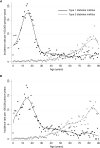Lifetime risk and health-care burden of diabetic ketoacidosis: A population-based study
- PMID: 36093075
- PMCID: PMC9449722
- DOI: 10.3389/fendo.2022.940990
Lifetime risk and health-care burden of diabetic ketoacidosis: A population-based study
Abstract
Objective: Diabetic ketoacidosis (DKA) is a life-threatening complication of both type 1 and type 2 diabetes. We aimed to assess population-based rates, trends and outcomes of patients with DKA.
Design and methods: This is a nationwide cohort study using hospital discharge claims data from 2010 to 2018 in Switzerland. Incidence rates and in-hospital outcomes of DKA were analyzed throughout lifetime for children (0-9 years), adolescents (10-19 years), and adults (20-29, 30-59, and 60-90 years). Analyses were stratified for type of diabetes mellitus and sex.
Results: In total, 5,544 hospitalizations with DKA were identified, of whom 3,847 were seen in patients with type 1 diabetes and 1,697 in type 2 diabetes. Incidence rates of DKA among patients with type 1 diabetes were highest during adolescence with 17.67 (girls) and 13.87 (boys) events per 100,000 person-years (incidence rate difference [IRD]: -3.80 [95% CI, -5.59 to -2.02]) and decreased with age in both sexes thereafter. Incidence rates of DKA in patients with type 2 diabetes were low up to an age of 40 years and rose to 5.26 (females) and 6.82 (males) per 100,000 person-years in adults aged 60-90 years. Diabetic ketoacidosis was associated with relevant health-care burden independent of age, sex, or type of diabetes. The population-based incidence rate of DKA increased over time from 7.22 per 100,000 person-years in 2010 to 9.49 per 100,000 person-years in 2018.
Conclusions: In type 1 diabetes highest incidence rates of DKA hospitalizations were observed among adolescent females. In comparison, in patients with type 2 diabetes the risk for DKA steadily increased with age with higher rates in adult males. Over the 9 year study period, incidence rates of DKA were increasing irrespective of type of diabetes. DKA was associated with a high burden of disease reflected by high rates of intensive care unit admission, prolonged hospital stay and high mortality rates, especially in elderly.
Keywords: coma (diabetic); hyperglycemic crisis; ketoacidosis (DKA); type 1 diabetes mellitus (T1D); type 2 diabetes mellitus.
Copyright © 2022 Ebrahimi, Kutz, Christ and Szinnai.
Conflict of interest statement
The authors declare that the research was conducted in the absence of any commercial or financial relationships that could be construed as a potential conflict of interest.
Figures



Similar articles
-
Trends in hospitalization for diabetic ketoacidosis in diabetic patients in Taiwan: analysis of national claims data, 1997-2005.J Formos Med Assoc. 2010 Oct;109(10):725-34. doi: 10.1016/S0929-6646(10)60117-9. J Formos Med Assoc. 2010. PMID: 20970069
-
Using population data to understand the epidemiology and risk factors for diabetic ketoacidosis in Australian children with type 1 diabetes.Pediatr Diabetes. 2019 Nov;20(7):901-908. doi: 10.1111/pedi.12891. Epub 2019 Jul 16. Pediatr Diabetes. 2019. PMID: 31291024
-
Pediatric Diabetic Ketoacidosis With Hyperosmolarity: Clinical Characteristics and Outcomes.Endocr Pract. 2018 Aug;24(8):726-732. doi: 10.4158/EP-2018-0120. Epub 2018 Aug 7. Endocr Pract. 2018. PMID: 30084686
-
Impact of the COVID-19 pandemic on the incidence and clinical outcomes of diabetic ketoacidosis among male and female children with type 1 diabetes: systematic review and meta-analysis.F1000Res. 2023 Aug 10;12:72. doi: 10.12688/f1000research.128687.2. eCollection 2023. F1000Res. 2023. PMID: 39262444 Free PMC article.
-
A systematic literature review on the burden of diabetic ketoacidosis in type 2 diabetes mellitus.Diabetes Obes Metab. 2025 May;27(5):2750-2767. doi: 10.1111/dom.16282. Epub 2025 Mar 3. Diabetes Obes Metab. 2025. PMID: 40028663 Free PMC article.
Cited by
-
Alcohol-Related Hospitalizations Among Adolescents and Young Adults with Type 1 Diabetes in Spain, 2016-2023.J Clin Med. 2025 Jun 8;14(12):4053. doi: 10.3390/jcm14124053. J Clin Med. 2025. PMID: 40565801 Free PMC article.
-
Perception and Awareness of Diabetes Mellites and Diabetes Ketoacidosis among the General Population in Sudair Area, Saudi Arabia.J Pharm Bioallied Sci. 2024 Dec;16(Suppl 4):S3908-S3911. doi: 10.4103/jpbs.jpbs_1333_24. Epub 2024 Dec 27. J Pharm Bioallied Sci. 2024. PMID: 39927012 Free PMC article.
-
Recovery time of diabetic ketoacidosis in Africa: Systematic review and meta-analysis.Metabol Open. 2025 May 15;26:100370. doi: 10.1016/j.metop.2025.100370. eCollection 2025 Jun. Metabol Open. 2025. PMID: 40491672 Free PMC article.
-
Lymphocyte-C-reactive protein ratio upon admission to predict disease progression and ICU admission in adult patients with diabetic ketoacidosis.Sci Rep. 2025 Jan 23;15(1):3012. doi: 10.1038/s41598-024-84054-3. Sci Rep. 2025. PMID: 39849007 Free PMC article.
-
The health economics of insulin therapy: How do we address the rising demands, costs, inequalities and barriers to achieving optimal outcomes.Diabetes Obes Metab. 2025 Jul;27 Suppl 5(Suppl 5):24-35. doi: 10.1111/dom.16488. Epub 2025 Jun 4. Diabetes Obes Metab. 2025. PMID: 40464081 Free PMC article.
References
-
- Holman N, Wild SH, Gregg EW, Valabhji J, Sattar N, Khunti K, et al. . Comparison of mortality in people with type 1 and type 2 diabetes by age of diagnosis: An incident population-based study in England and Wales. Lancet Diabetes Endocrinol (2021) 10:95–97. doi: 10.1016/S2213-8587(21)00293-X - DOI - PubMed
Publication types
MeSH terms
LinkOut - more resources
Full Text Sources
Medical

